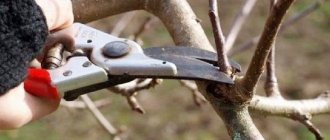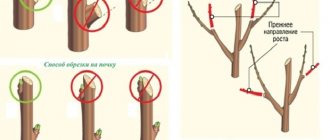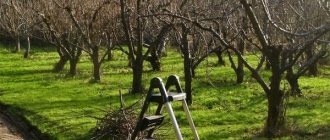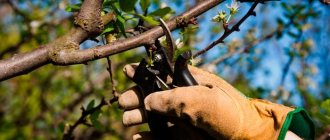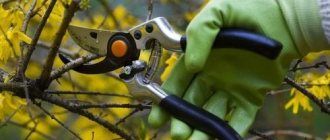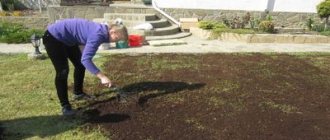Pruning apple trees in spring: timing
Trees begin to be pruned at a time when there is no intense sap flow .
The deadline for pruning apple trees in the spring in the Moscow region and central regions of Russia is the end of March, but if there is still snow on the site, then wait until it melts. It is better that the air temperature is above zero.
In April, shoots are cut off from trees in the north. It is necessary to prune before the buds begin to swell. Pruning a young tree with budding buds greatly reduces the number of fruits.
Important! Young apple trees are pruned in spring and autumn, and old apple trees in the spring so that the wounds have time to heal.
Information for beginner gardeners
There are three types of fruit branches:
- ringlet _ A short shoot up to 5 cm long with a large bud at the end. There are ring-shaped scars. The ringlets produce the most fruit;
- spear _ A shoot up to 15 cm long extending at a wide angle. Buds - several, with short spines, located close to each other;
- fruit twig. A thin one-year-old branch, at the end of which a flower bud forms. The length of the twig is from 15 cm.
Schemes for pruning apple trees in spring
When pruning apple trees in the spring, the patterns for cutting branches on adult and young trees are different, but there are also similarities.
The choice of pattern for pruning the crown in the spring depends on the goals and age of the apple tree .
Why pruning apple trees in spring :
- Improvement of the apple tree;
- It is required to make it convenient to pick apples;
- For the growth of strong young shoots in the required direction;
- For good oxygen penetration and illumination of the tree;
- Cutting dry and damaged branches.
A tree that has a dense crown produces small apples, their number is significantly less than that of a well-groomed tree. It is especially important to know how to prune an apple tree in the spring for beginners.
The crown shape can be different:
- Medium-standard;
- Fusiform;
- Combined;
- Sparsely tiered.
Important! It is easiest to form a sparsely tiered crown. To do this, you need to leave 5 skeletal branches at a distance of 35-40 cm from one another, and cut off the excess ones.
a medium-standard crown if you cut off all the branches located at a height of 0.8-1.1 m from the ground surface. All remaining branches develop on their own.
Required tools and materials for proper pruning of apple trees in spring:
- Garden hacksaw;
- Lopper;
- Saw;
- Garden var;
- Secateurs.
Trimming tools
It is important to choose the right tool. You can use hacksaws, pruning shears and saws.
The saws used are not construction saws, but special garden saws that have small teeth. This saw causes less damage to the wood at the beginning of the cut. For tall fruit trees, use a lopper. It allows you to reach the most inaccessible branches.
All tools must be clean, well sharpened and free of rust when used. Can be treated with alcohol or other disinfectant.
It is recommended to process the tool after each tree to avoid transfer of fungus from one apple tree to another.
Pruning an apple tree 2-3 years in the spring: diagram and video
The apple tree already has a trunk and branches extending from it. In trees that have not yet produced apples, shoots are cut off at an acute angle, which prevent the main branches from growing.
If you want to have an idea of how to prune an apple tree in the spring, the diagram is standard for all fruit trees. Next, spring pruning of apple trees will be presented in the video.
The correct pruning of apple trees in spring is as follows:
- Leave 3-5 strong branches extending from the trunk at almost right angles, and cut off the rest that extend at sharp angles. This should be done because branches located at an acute angle from the trunk may break off under the weight of the apples.
By the way, you can stretch the shoots so that they stand horizontally by placing spacers. Make the central conductor above the largest bud; a vertical shoot will grow from it. It should be 4-5 buds higher than all shoots.
- The branches remaining after pruning are trimmed so that those growing from below are 30 cm longer, and the upper ones are shorter.
This is how the crown of apple trees that are 2 years old is formed; when it grows, it will be round.
Advice: Do not prune shoots for 3-5 years. Otherwise they will not be able to bear fruit. Only diseased, frostbitten, cracked branches at the base are pruned.
Watch how to prune apple trees in the spring, a video about pruning before fruiting:
Correct pruning technique
Bud pruning
This is done to give the shoot the desired direction of growth. Shorten to a bud located on the outside of the branch. Make an oblique cut at 45 degrees. The stump is left 1 cm away. It cannot be closer, otherwise you can damage the kidney.
Trimming to ring
The woody growth at the very base of a thickened branch is called a ring. The cut should only be made along the outer edge. Then it will be covered with new bark and will not cause any harm. If the cut is too close, it will rot. It is even possible that a hollow will form. Before cutting a thick branch, you need to make a cut from the bottom and then saw it. Otherwise, it may collapse, peeling off the bark.
The cut needs to be cleaned with a knife and covered with a mixture of fresh mullein and clay, or oil paint.
Side branch pruning
A side branch is made when two branches grow from the same place and a fork forms. The damaged surface is treated.
Crown formation in a dwarf apple tree
Dwarf trees are already popular all over the world. They begin to bear fruit in the third year. They also need spring pruning. They begin to form the crown immediately after planting.
Cut it to 50 cm, using the bud cut method. By the end of the season, 4-5 shoots will appear, of which the top one will grow almost vertically. This is the future guide. After a year, it is pruned 20 cm from the base of the growth.
The conductor must have a vertical direction. The remaining branches are cut 20 cm from the base. The side branches are cut into three leaves, and the shoots of the second level are cut into the very first leaf. In the third year and beyond they continue in the same way. When the tree has grown enough, it will be necessary to remove the growth from the guide. Growth from the skeletal main branches is removed by 40–50 cm. The apple tree should take the shape of a pyramid.
Formation of a columnar apple tree
The columnar apple tree is a tree with a single trunk, from which short shoots extend. They are called ringlets. Requires minimal pruning.
The main trunk cannot be shortened. The crown is formed in three springs:
- In the first year, all unnecessary side branches are cut off for only two buds.
- On the second, horizontal branches of 30 cm are removed. Vertical branches near the main trunk are not touched. They are needed for future apples.
- In the third spring, the upper shoot is slightly shortened, last year's branches are cut by 25 cm and the upper regrown shoots are shortened by two buds. A few shoots are left for fruit.
At five years, they begin to limit the further growth of the tree. The top is the weakest zone of a columnar apple tree. Frost and wind can damage it. Then you can form trunks from two side branches.
Pruning old and young apple trees
Pruning young annual apple trees
A one-year-old seedling usually does not yet have branches. But pruning is carried out to restore the balance between the roots damaged by transplantation and the intact trunk.
Step back 1 m up the trunk, then cut, then new shoots will grow.
See how to prune an apple tree in spring. Video from an experienced gardener about working with a seedling:
Pruning old apple trees
The yield decreases for several reasons:
- Lack of lighting;
- Growth of excess growth;
- Incorrectly formed crown;
- Dried branches.
Before you begin the main pruning , you need to cut off the internal shoots from the main branches and trunk. Then the top of the branches is cut off to improve light and oxygen access.
To achieve the desired result, you need to cut off 1/3 of the shoots and branches. They are not cut off immediately, but over the course of several years.
Trim those shoots that grow at an acute angle to the trunk.
Branches that are more than 3 years old need to be cut off, leaving 6 cm. If shoots appear on them, then leave the strongest one.
Detailed instructions for caring for an apple tree in spring: pruning on a video about procedures after rejuvenation:
Everything you need to know about tree pruning
Pruning is very important for apple trees. As the tree grows, the crown thickens, there are more branches, and they transmit less light necessary for the ripening of apples. This affects both the quantity and quality of the harvest. There are fewer apples, they become smaller and their taste worsens.
In a dense crown there is a high risk of pests that damage the bark and destroy the foliage. In addition, excess moisture collects in the dense crown, which provokes fungal diseases. Another important reason is ripe fruits. When the crown is thickened, harvesting is difficult, apples often remain hanging on the branches, begin to rot, and become a breeding ground for diseases and pests.
Gardeners advise pruning every year without fail. This will help long-term fruiting and increase productivity. In addition, it will protect against pests.
Thus, its goals are:
- formation of the apple tree crown;
- regulation of proper growth and stable fruiting;
- regulating the apple tree's needs for nutrients and water;
- improving the quality characteristics of the future harvest;
- improvement of air and light conditions.
If you do not trim, then:
- many unnecessary forks are formed;
- dry intertwined branches are formed;
- superfluous shoots are formed;
- shoots grow on apple tree roots;
- wood becomes fragile;
- the period of the beginning of fruiting is delayed.
There are three types of pruning:
- Sanitary pruning. Bad, dry, fungus-affected branches are removed.
- Rejuvenating. The branches are shortened to stimulate growth and increase the number of fruits.
- Formative. They create a developed trunk and a regular crown for the tree.
The process begins by removing all frozen and dry branches. Frozen branches do not bear fruit, and the apple tree will only waste energy restoring them. Then all annual young shoots are removed. They take food from the main tree.
The remaining branches are cut off according to the height of the tree. The taller the tree, the greater the number of buds left on the branches. At least eight eyes are left on the branches of tall trees.
It is recommended to lay the crown in three main tiers. The first consists of three skeletal branches. The second should contain three main taps. And the third is two branches. After the apple tree is five years old, the main trunk is shortened. This formation is ideal. It is not recommended to make more tiers; this will greatly complicate harvesting.
Rules for pruning apple trees
- Select the main skeletal branches located around the trunk at an angle of 45 degrees. Spacers must be used if they are not available.
- Conventionally, the crown should be divided into the necessary tiers. Three recommended. The main branches on each of them are made the same length. The excess is removed.
- The proposed trunk is made 30-50 cm higher than the branches of the uppermost tier.
- The branches of the lowest tier should be longer than the upper branches
- The branches of the second, which grow on skeletal ones, should be 20-25 cm from the base.
- Shoots that grow inward and upward are usually removed, but shoots that grow downward and horizontally can be left. They are needed for future fruits.
- Annual shoots over 60 cm are pruned.
How to prune apple trees in spring: video training
Watch a detailed video lesson on pruning an apple tree in spring for beginners:
Master class from the gardening club on how to properly prune an apple tree in the spring on video:
Advice! After pruning, it is recommended to inspect the apple trees: if you see moss or lichen, scrape them off with a plastic scraper, then treat them with copper sulfate, and then with garden varnish.
Mosses will not harm the tree if there are few of them, but when they spread along the trunk, they will limit the access of air to it, after which all the branches will dry out.
To eliminate lichens, make a composition of 1 part clay and 1 part slaked lime, mix, pour in water until the thickness of regular sour cream.
Apply the mixture to the lichen, leave for a while to dry, then carefully scrape off. Next, wait for the bark to dry, cover it with garden varnish, and lubricate the tree trunk with iron sulfate 3%.
Correct formation of the crown of dwarf apple trees
Dwarf apple trees also need shaping, like trees with a standard crown:
- In the first spring, the trunk of the apple tree is trimmed, leaving it at a level of 50 cm. By the end of summer, several strong branches will appear on the trunk.
- In the spring, the central conductor of a two-year-old apple tree is pruned and the side shoots growing downwards are completely cut out.
- In the third year of life, the central branch is shortened by 5-10 cm, the side shoots need to be shortened by 20 cm.
- In mature trees, the lateral branches are pruned annually so that their length does not exceed 0.5 m.
The height of the apple tree is adjusted by trimming the conductor. Dwarf varieties should not be higher than 2-2.5 m.
Recipes for preparing garden varnish:
Var Zhukovsky
It is used exclusively in warm weather , since in frosty weather it is hard.
Place in a bowl 1 part rosin, 1 part yellowish wax and 1 part melted warm beef fat. Stir gently until smooth.
Wait for the mixture to cool.
Treatment of an apple tree after pruning with Zhukovsky's var.
Pour cold water into a deep saucepan, pour in the mixture, wait a while for it to curdle. Take it out and mold it into a ball.
You can wrap the composition in several layers of oiled paper and store . When you apply the varnish to the wounds, cover it with a cloth so as not to attract pollinating insects.
Var Pashkevich
Made from 1 part wax, 1 part turpentine, ½ part rosin and ¼ part fat .
Choose metal utensils that can be placed on the fire.
Place the wax in it and melt it until it becomes liquid. Do not remove the cookware from the heat. Add to it the same part of turpentine and half of the purified rosin. When the composition is homogeneous, add ¼ of the fat.
Also fill a container with cold water and place the brew in it.
Watch a useful video on how to make rosin:
Var is stored in oiled paper.
To use, spread a thin layer of varnish on a cotton cloth and wrap the cloth over the wound.
Advice! Varis that can be used in winter: Gaug, Reshetnikov, Raevsky.
Var Gauta
Place 400 g of pine resin in a metal bowl, heat it, pour in 60 ml of pure medical alcohol. Pour 1 teaspoon of baking soda and 4 g of gum into water, then pour the composition into a bowl with resin and alcohol, mix everything, cool.
Apply with a brush to cracks and cuts.
Reshetnikov ointment
of fir resin in a metal bowl , place on low heat, leave until melted, stirring continuously.
After cooling the ointment, but so that it remains warm, pour in 1 part of wine alcohol.
Use a brush to lubricate the wounds.
The ointment can be used even in frosty conditions . It does not allow water to pass through, and no cracks appear on it.
Var Raevsky
Melt half a kilogram of tree resin , stir constantly, pour in 60 ml of medical alcohol and 2 tbsp. spoons of flax oil.
Mix and store in a tin jar .
What means are used to treat cut sites?
Branches whose cut diameter reaches 1 cm or more must be treated with special means so that infection does not enter the wound and healing proceeds faster. These can be store-bought compounds and putties made at home.
Garden varieties
This group includes products made from beeswax, propolis, rosin and alcohol. Garden pitch is a kind of putty for treating wounds, including those caused by pruning trees.
Most often, this product is sold in solid form; it will have to be melted before use. This can be done in a water bath or simply by leaving the product in the sun until softened.
Before applying the varnish, the cut is disinfected with brilliant green or a solution of copper sulfate. After this, apply the putty in a thin, even layer, without gaps. At the end of the procedure, experts recommend tying the treated area with a breathable cloth. Garden varnish is inexpensive. Depending on the manufacturer, the price per package is from 40 to 100 rubles. The product is also available in the form of an aerosol, which is significantly more expensive.
Putty recipes
In addition to garden varnish, other means can be used to treat wounds on fruit trees. Summer residents often use:
- Oil or emulsion paint. These products are quite suitable for sealing wounds and protecting the cut from the penetration of moisture and harmful bacteria. However, paints can be washed off by rain. From time to time they will have to be reapplied.
- Clay mixture. To prepare this putty, you need to mix 2 parts clay, 1 part cow dung and a little chopped straw or hay. After combining the components, the mixture should have a consistency similar to sour cream.
- Cement putty. To 1 part of cement add 3 parts of fine sand and dilute with water to the desired consistency. For elasticity, you can add a little drying oil to the putty.
On a note! If none of the above is at hand, you can cover the cut with ordinary garden soil, rubbing it thoroughly into the wound. This is exactly what our ancestors once did.
We specify the date according to the lunar calendar
The apple tree, like all living things on Earth, in its development largely depends on the lunar rhythm. The moon is known to go through four phases:
- new moon;
- Waxing Crescent;
- full moon;
- waning moon.
If you adhere to the recommendations of the lunar calendar, then pruning of the crop in question should be done only on the waning moon. This is explained by the fact that sap flow slows down during this period, and the resulting wounds after gardening operations heal faster. You should not prune an apple tree during the full moon or new moon, as the plant will be prone to disease. If you use pruning shears for the operation while the moon is waxing, the tree will receive severe stress. When choosing a suitable day for this event, it is necessary to take into account the season, ambient temperature and phase of the moon.



